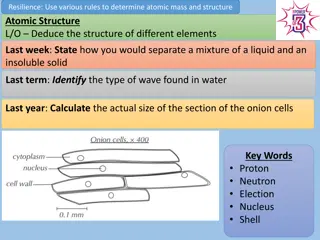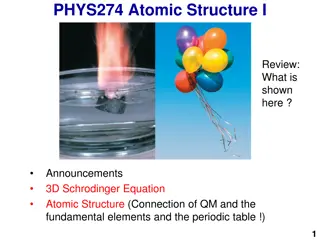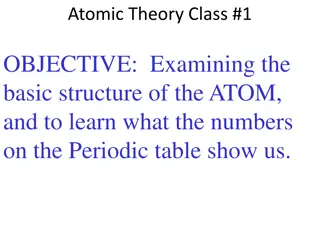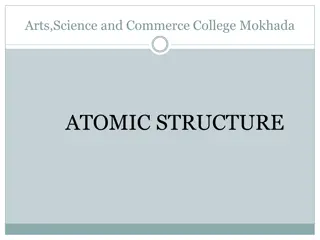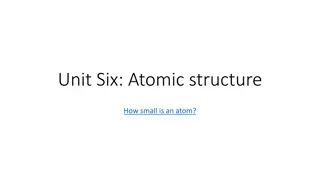Exploring the Fundamentals of Atomic Structure and Matter
Delve into the intricate world of atomic structure and matter through a comprehensive study covering topics such as subatomic particles, atomic models, and key concepts like atomic number and mass. Explore the fascinating properties of atoms, their components, and their interactions, gaining insights that form the foundation of chemistry and physics.
Download Presentation

Please find below an Image/Link to download the presentation.
The content on the website is provided AS IS for your information and personal use only. It may not be sold, licensed, or shared on other websites without obtaining consent from the author. Download presentation by click this link. If you encounter any issues during the download, it is possible that the publisher has removed the file from their server.
E N D
Presentation Transcript
https://4.bp.blogspot.com/-BZ5V1b6uE4w/WqptgzOKsbI/AAAAAAAAGTU/ZyzeRg8V4GcQmzXQau_3zA8GaZ9s8ZwOgCLcBGAs/s640/science.jpghttps://4.bp.blogspot.com/-BZ5V1b6uE4w/WqptgzOKsbI/AAAAAAAAGTU/ZyzeRg8V4GcQmzXQau_3zA8GaZ9s8ZwOgCLcBGAs/s640/science.jpg
Character Strength: Character Strength: Atomic Structure Atomic Structure Learning Objective: Learning Objective: To be able to describe the structure of an atom, and identify the number of protons, neutrons and electrons in atoms Last week: State State the type of particles used to show the existence of electrons being in a cloud around the nucleus of an atom Last term: Calculate water by 25C, if the specific heat capacity of water is 4200kg/C Calculate the energy required to raise the temperature of 2.5kg of Last year: State State the atomic model that we use today in Chemistry and Physics Links to your future: Links to your future: Keywords Keywords Atomic Number Relative Atomic Mass Electron Configuration The basis of all matter The basis of all matter We will go on to learn We will go on to learn about States of matter and interconversions We have learnt We have learnt about the history of the atom We are learning We are learning about Atomic structure
Fail Task Draw and label an atom (5 labels) and fill in the information in the table. Subatomic Particle Mass Charge Location
Sail Task Draw and label an atom (5 labels) and fill in the information in the table. Subatomic Particle Mass Charge Location
Atom facts They have a radius of an atom is about 1 X 10-10 meters In a 50p piece there are 77400000000000000000000 (20 0 s) atoms The radius of the nucleus of an atom is 1 X 10-14 meters That is 1/10000 of the size of an atom or your fist in the Royal Albert Hall
Complete the attached worksheet using the periodic table below
Element Atomic number Mass number Number of protons Number of neutrons Number of electrons Hydrogen 1 1 1 0 1 Helium 2 4 2 2 2 Lithium 3 7 3 4 3 Beryllium 4 9 4 5 4 Boron 5 11 5 6 5 Carbon 6 12 6 6 6 Nitrogen 7 14 7 7 7 Oxygen 8 16 8 8 8 Fluorine 9 19 9 10 9 Neon 10 20 10 10 10 Sodium 11 23 11 12 11 Magnesium 12 24 12 12 12 Aluminium 13 27 13 14 13 Silicon 14 28 14 14 14 Phosphorus 15 31 15 16 15 Sulfur 16 32 16 16 16 Chlorine 17 35 17 18 17 Argon 18 40 18 22 18 Potassium 19 39 19 20 19 Calcium 20 40 20 20 20
1. They go up in 1s. 2. Atomic number, number of protons and number of electrons. 3. Hydrogen mass number is 1 which is the same as its atomic number. 4. Hydrogen. 5. Helium, carbon, nitrogen, oxygen, neon, magnesium, silicon, sulfur, calcium. 6. They increase by 8. 7. Yes. 8. a)sodium, b) fluorine, c) helium Add the neutrons and protons together to work out the mass number. Or match the number of electrons (or protons) to the atomic number. 1. a)chlorine b) sodium c) lithium The number of electrons equals the number of protons (which is the same as the atomic number). Find the element with that atomic number. 1. a) 6 neutrons b) 7 neutrons c) 8 neutrons d) 10 neutrons e) 10 neutrons Look at the number of electrons. The number of electrons equals the number of protons, then look for the elements with the same atomic number as the number of electrons. Then take the mass number and subtract the atomic number from it.
Electron Configuration How many electrons are in each electron shell? Shell 1 - 2 Shell 2 - 8 Shell 3 8 What resource can we use to check how many electrons are the outer shell of an atom? We can use the periodic table the group number tells you how many electrons are in the outer shell of each element. E.g. If in Group 1, it 1 electron in the outer shell, if in Group 7, it has 7.
1. helium 2. carbon 3. sulfur 4. magnesium 5. aluminium 6. argon
1. N nitrogen 2,5 2. P phosphorus 2,8,5 3. B boron 2,3 4. Cl chlorine 2,8,7 5. Ne neon 2,8 6. Ca calcium 2,8,8,2
Group 1 Atomic number Electron configuration Group 0 Atomic number Symbol Symbol Electron configuration lithium Li 3 2,1 helium He 2 2 sodium Na 11 2,8,1 neon Ne 10 2,8 potassium K 19 2,8,8,1 argon Ar 18 2,8,8
1. As you go down the table the next element has 8 more electrons. Each outer shell has 1 electron. 2. As you go down the table the next element has 8 more electrons. Each outer shell is full. 3. As you go down the table the next element has 8 more electrons. Each outer shell has 2 electrons.







